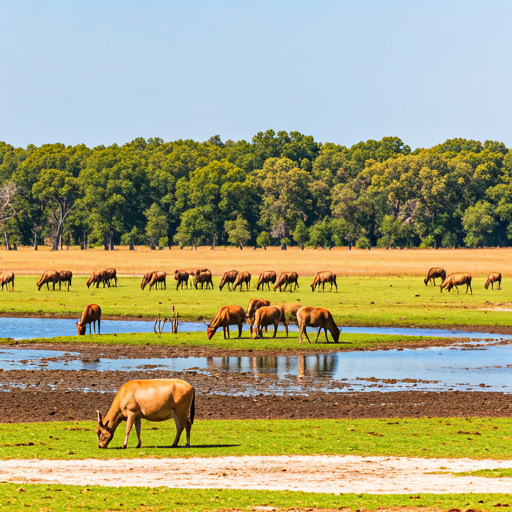The Tarai region of Uttar Pradesh, located in the foothills of the Himalayas, is a unique and ecologically significant area that harbors a diverse array of wildlife and plant species. This region plays a crucial role in maintaining the biodiversity and ecological balance of the state, and the wildlife sanctuaries in the Tarai region are vital in conserving these valuable natural resources. The combination of rich flora, fauna, and the ecological services provided by the Tarai’s wetlands, forests, and grasslands makes the wildlife sanctuaries in this region indispensable for both conservation efforts and local communities.
In this article, we will explore the ecological importance of the wildlife sanctuaries in the Tarai region of Uttar Pradesh, focusing on their role in biodiversity conservation, water regulation, carbon sequestration, and the socio-economic benefits they provide.
1. The Tarai Region of Uttar Pradesh: An Overview
The Tarai is a belt of marshy, swampy land at the base of the Himalayan foothills, stretching across parts of Uttarakhand and Uttar Pradesh. It is characterized by its rich biodiversity, wetlands, and dense forests. The region is an ecological transition zone between the higher Himalayan mountain ecosystems and the plains of the Gangetic basin.
The Tarai is home to a variety of ecosystems, including:
- Tropical and subtropical forests with diverse flora and fauna.
- Wetlands, which serve as important breeding grounds for various species.
- Grasslands, which provide critical habitat for herbivores and other wildlife.
- Rivers and streams that feed into the Ganga and other tributaries, contributing to the hydrological system of the region.
Several wildlife sanctuaries are located in the Tarai region of Uttar Pradesh, including the Dudhwa Tiger Reserve, Katerniaghat Wildlife Sanctuary, and Sultanpur Bird Sanctuary. These sanctuaries have become essential for the protection and conservation of the region’s unique biodiversity.
2. Biodiversity Conservation in the Tarai Region
One of the most significant ecological contributions of the wildlife sanctuaries in the Tarai region is their role in preserving biodiversity. The Tarai is home to a wide range of species, many of which are endemic, rare, or endangered. Some of the key species found in the wildlife sanctuaries of the Tarai region include:
a) Mammals:
- Tigers: The Dudhwa Tiger Reserve is home to the Bengal tiger, a species listed as endangered. The reserve provides a safe habitat for tigers and plays a crucial role in protecting their population.
- Elephants: The Tarai Elephant Reserve serves as a critical habitat for wild elephants, which are found in several parts of the Tarai region.
- Leopards: The Tarai also supports populations of leopards, which thrive in the dense forests of the area.
- One-Horned Rhinoceros: The Dudhwa Tiger Reserve is home to the Indian rhinoceros, which is one of the few places in India where this species can be found outside the Kaziranga National Park.
b) Birds:
- The Katerniaghat Wildlife Sanctuary and Sultanpur Bird Sanctuary are renowned for bird conservation. These sanctuaries serve as important habitats for migratory birds, particularly during the winter season. Species such as the Sarus crane, migratory ducks, and flamingos are found here.
- The Sultanpur Bird Sanctuary is located along the migratory route of birds traveling from Central Asia to the Indian subcontinent, making it a vital stopover for many species.
c) Reptiles and Amphibians:
- The sanctuaries also support populations of reptiles, including the Indian cobra, python, and various species of turtles.
- Amphibians like the Indian bullfrog and common toad thrive in the wetland ecosystems of the region.
d) Flora:
- The Tarai forests are rich in flora, including species such as sal trees, bamboo, teak, and various species of grasses and herbs.
- The region also supports important medicinal plants and species that contribute to the local ecosystem and economy.
3. Ecological Functions of Wildlife Sanctuaries in the Tarai Region
The wildlife sanctuaries in the Tarai region of Uttar Pradesh perform a range of critical ecological functions that contribute to environmental sustainability. Some of these functions include:
a) Water Regulation and Flood Control
The Tarai region is characterized by numerous rivers, streams, and wetlands. These wetlands play a vital role in water regulation, acting as natural sponges that absorb excess water during the monsoon season and release it slowly during the dry months. The wildlife sanctuaries in the Tarai help in preserving these wetlands and ensuring that the hydrological system of the region remains intact.
- Flood Mitigation: Wetlands act as natural buffers against floods by absorbing rainwater and preventing its rapid runoff into downstream areas. The sanctuaries help preserve these wetland ecosystems, which in turn protect surrounding communities from flood risks.
- Groundwater Recharge: The preservation of forested areas and wetlands contributes to groundwater recharge, ensuring that water is available for local communities and agriculture throughout the year.
b) Carbon Sequestration and Climate Regulation
The wildlife sanctuaries in the Tarai region, particularly the dense forests, play an important role in climate regulation. Forests act as carbon sinks, absorbing carbon dioxide from the atmosphere and storing it in plant biomass. This process of carbon sequestration helps mitigate the effects of climate change by reducing the overall concentration of greenhouse gases in the atmosphere.
- Forests and Grasslands: The forests of the Tarai region are rich in biodiversity and play a crucial role in stabilizing the local climate by regulating temperature and humidity levels.
- Wetlands: Wetlands also serve as carbon sinks, storing carbon in their waterlogged soils. This contributes to reducing the region’s overall carbon footprint.
c) Soil Conservation and Erosion Prevention
The vegetation in the wildlife sanctuaries, particularly grasses, shrubs, and trees, plays a significant role in preventing soil erosion. The Tarai region is prone to soil erosion due to its proximity to the Himalayas, but the presence of healthy forests and grasslands helps stabilize the soil, reducing the impact of monsoon rains and preventing landslides.
- Root Systems: The deep root systems of trees and plants anchor the soil, preventing it from being washed away by heavy rainfall.
- Grasslands: Grasslands help prevent surface soil erosion by acting as a protective layer, reducing wind and water erosion.
4. Socio-Economic Importance of Wildlife Sanctuaries
In addition to their ecological functions, the wildlife sanctuaries in the Tarai region also provide significant socio-economic benefits to the local communities and the state of Uttar Pradesh. Some of these benefits include:
a) Eco-Tourism
The wildlife sanctuaries in the Tarai attract tourists from across the world, generating revenue and employment opportunities. Eco-tourism not only provides financial benefits to local communities but also raises awareness about the importance of wildlife conservation. The Dudhwa Tiger Reserve, Katerniaghat Sanctuary, and Sultanpur Bird Sanctuary are popular destinations for wildlife enthusiasts, birdwatchers, and nature lovers.
- Job Creation: Local communities benefit from employment opportunities in eco-tourism, including roles as guides, hospitality workers, and conservation staff.
- Revenue Generation: The tourism industry generates revenue that can be reinvested into conservation efforts and community development.
b) Livelihood Support for Local Communities
The sanctuaries support the livelihoods of local communities by providing sustainable resources, including non-timber forest products (NTFPs) such as medicinal plants, fruits, and firewood. Additionally, the sanctuaries serve as important sources of water and food for local farmers and communities.
- Sustainable Livelihoods: The sanctuaries provide resources that can be sustainably harvested, contributing to the economic well-being of surrounding communities.
- Community Participation: Local communities are often involved in conservation efforts, creating a sense of ownership and responsibility toward protecting these valuable ecosystems.
5. Challenges and Conservation Efforts
While the wildlife sanctuaries in the Tarai region are essential for conservation, they face several challenges:
- Poaching: Illegal hunting and poaching of wildlife, especially tigers and elephants, remain a threat to the biodiversity of the region.
- Habitat Fragmentation: Development activities such as deforestation, agriculture, and urbanization lead to habitat fragmentation, making it difficult for wildlife to migrate and find food.
- Climate Change: Shifting weather patterns and rising temperatures threaten the delicate balance of the Tarai ecosystem.
Efforts to address these challenges include stronger law enforcement, habitat restoration projects, community engagement in conservation, and the implementation of climate adaptation strategies.
6. Conclusion
The wildlife sanctuaries in the Tarai region of Uttar Pradesh play an essential role in preserving the region’s rich biodiversity and maintaining ecological balance. These sanctuaries provide critical ecosystem services such as water regulation, flood control, carbon sequestration, and soil conservation. Moreover, they offer socio-economic benefits, including eco-tourism opportunities and support for local livelihoods. As such, the wildlife sanctuaries in the Tarai region are integral to both ecological conservation and the well-being of local communities. Protecting and maintaining these sanctuaries is not only crucial for wildlife but also for the sustainable development of Uttar Pradesh as a whole.




